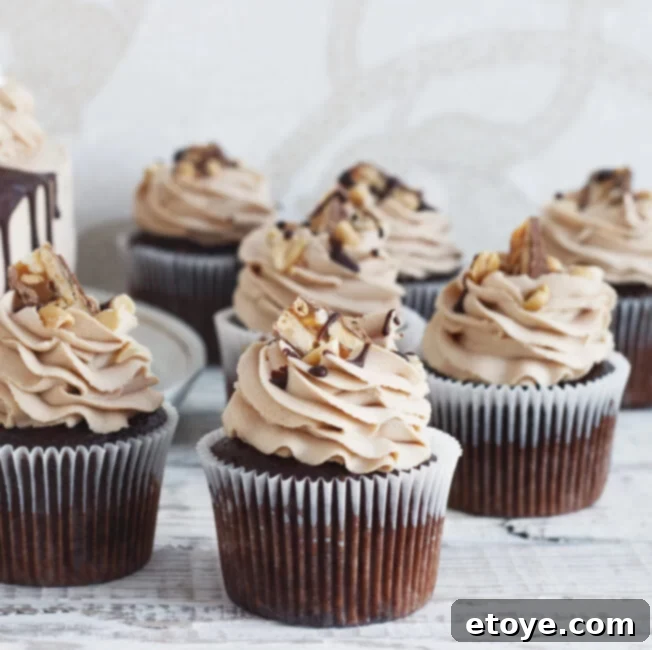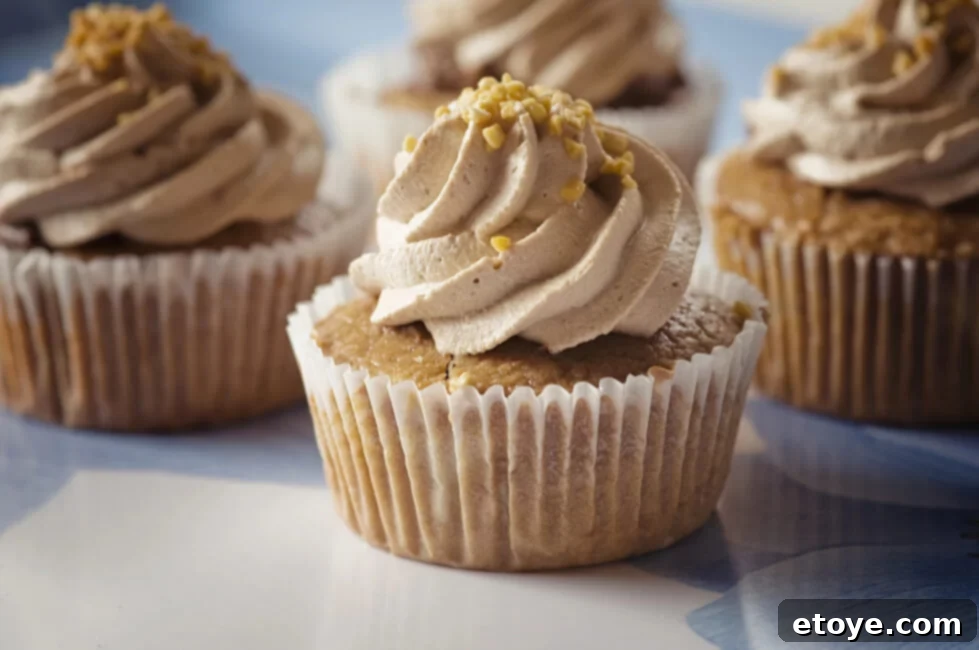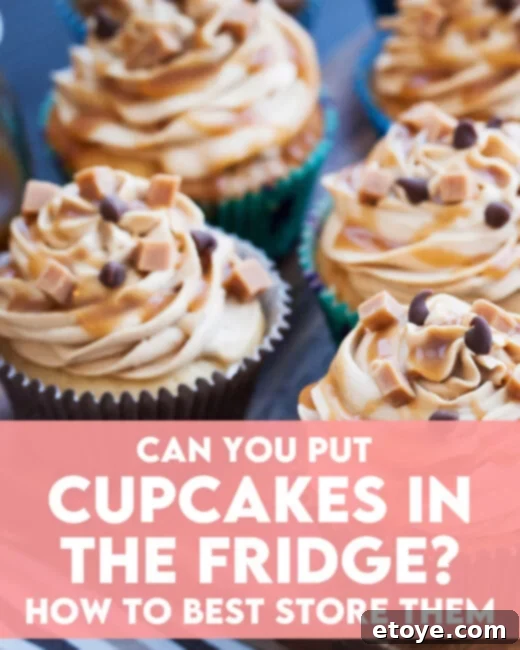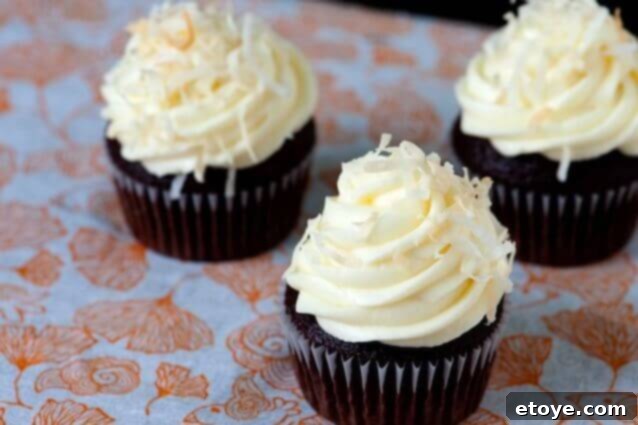Have you just baked a delightful batch of cupcakes or brought home some tempting treats, only to wonder about the best way to store them? The common dilemma arises: do cupcakes belong on the counter like a fresh loaf of bread, or should they be tucked away in the refrigerator? Missteps in storage can quickly lead to stale, dry pastries or, worse, spoiled delights. Whether you’re dealing with cherished homemade cupcakes crafted with love or convenient store-bought cupcakes, ensuring their freshness and optimal taste is paramount. This comprehensive guide will transform you into a cupcake storage expert, allowing you to savor these sweet, puffy wonders in their freshest state for as long as possible, maintaining their irresistible texture and flavor.

The Great Cupcake Refrigeration Debate: To Chill or Not To Chill?
The question, “Can you put cupcakes in the fridge?” often receives a resounding “Yes, but with crucial caveats.” While refrigerating cupcakes in an airtight container might seem like the most intuitive way to preserve them, it’s not always the optimal solution for every type of cupcake. A refrigerator’s dry environment is notoriously efficient at drawing moisture from baked goods, potentially transforming a perfectly moist cupcake into a dry, unappetizing pastry husk. However, the rules change drastically for cupcakes adorned with specific toppings. Any cupcake featuring cream cheese frosting, delicate whipped cream, or other dairy-based components absolutely REQUIRES refrigeration to prevent bacterial growth and premature spoilage. This delicate balance between preserving moisture and preventing spoilage can be confusing, but understanding these nuances is key to keeping your cupcakes irresistibly delicious and perfectly “cup-cakiest.”
Mastering Cupcake Storage: Essential Techniques for Ultimate Freshness
Cupcakes, in all their delightful forms, bring joy. From the meticulous baking process to the pure pleasure of indulgence, they are miniature celebrations. Proper storage isn’t just about extending shelf life; it’s about preserving that joyful experience, ensuring every bite is as fresh and flavorful as the first. Whether you’re safeguarding fresh homemade cupcakes or managing a batch of store-bought leftovers, employing the right storage techniques will significantly extend their life and maintain their quality. Let’s explore the best practices to keep your cupcake party going strong.
At Room Temperature: The Sanctuary for Unfrosted and Specific Frosted Cupcakes
For many cupcakes, particularly those without perishable frostings or fillings, room temperature provides the ideal environment. It helps maintain their soft crumb and moist interior, preventing the dryness that can sometimes occur in the fridge.
- Cool, Dry, and Out of Sunlight: For optimal results, store your unfrosted or certain buttercream-frosted cupcakes in a cool, dry place, away from direct sunlight or heat sources like ovens or windows. High temperatures can cause frostings to melt and cake batters to dry out quickly, while humidity can lead to a sticky texture. An ideal room temperature is typically between 65-72°F (18-22°C). This environment ensures the cake remains soft on the outside and wonderfully moist within, preserving both texture and taste for several days.
- The Power of an Airtight Container: This is arguably the most critical step for room temperature storage. Keeping cupcakes in an airtight container shields them from exposure to air, which is the primary culprit behind drying out and staleness. The sealed environment locks in moisture, preventing your cupcakes from becoming hard and crumbly. Furthermore, an airtight seal protects your cupcakes from absorbing any external odors present in your kitchen and maintains their pristine, fresh flavor. Use containers with tight-fitting lids, or even a cake dome, to create this protective barrier.
- Allow Them Breathing Room: While cupcakes are charming, they can be a bit particular about their personal space. Avoid overcrowding them in a container. Giving each cupcake ample room prevents them from touching, which is vital for proper air circulation. This space helps prevent moisture from accumulating around them, which can lead to soggy bottoms, sticky tops, or even smudged frosting. If you’re storing a larger batch, consider utilizing multiple containers or layering cupcakes gently with sheets of parchment paper between layers. This ensures each individual cupcake remains a star, maintaining its perfect shape and freshness.
Understanding Cupcake Varieties and Their Tailored Storage Needs
Not all cupcakes are created equal, and their unique compositions dictate the most appropriate storage methods. Recognizing the different types of cupcakes you’re handling is the first step toward preserving their perfection.
- Plain Cupcakes (Unfrosted): These are the easiest to store and generally thrive at room temperature. Without any perishable toppings, they can remain wonderfully fresh in an airtight container for up to 2-3 days. Their simple nature makes them less susceptible to drying out or spoilage in a controlled environment.
- Classic Frosted Cupcakes: The need for refrigeration here largely depends on the frosting type.
- Buttercream, Ganache, Fondant, or Royal Icing: Most classic buttercreams made primarily with butter and powdered sugar, as well as ganache, fondant, and royal icing, are generally stable at room temperature for up to 2-3 days. However, if your kitchen is particularly warm or humid, refrigeration for a short period might be beneficial to prevent melting or stickiness.
- Cream Cheese Frosting, Whipped Cream, Meringue-Based Frostings: These delightful toppings are highly perishable due to their dairy or egg content. Cupcakes adorned with cream cheese frosting, whipped cream, or delicate meringue-based frostings (like Swiss or Italian meringue buttercream) absolutely require a cooler environment. They must be refrigerated immediately to prevent spoilage and ensure food safety.
- Cupcakes with Perishable Fillings: Any cupcake that contains delicate fillings such as fresh fruit, fruit curds, custard, pastry cream, or other dairy products must be refrigerated without exception. These fillings are highly susceptible to bacterial growth and spoilage at room temperature, making cold storage a mandatory step to ensure both safety and taste.

Refrigerating Cupcakes: Best Practices for Delicate Treats
For those cupcakes that mandate refrigeration due to their ingredients, proper technique is essential to minimize the drying effect of the fridge while ensuring safety. To maintain their freshness and, crucially, prevent them from absorbing unwanted odors from other foods, always store them in an airtight container. If the container isn’t perfectly sealed, consider adding an extra layer of plastic wrap directly over the cupcakes before sealing the lid. Ideally, refrigerated cupcakes should be enjoyed within 3-4 days. For the ultimate enjoyment, always allow them to return to room temperature for about 15-30 minutes before serving. This brief period helps the cake soften, the frosting regain its creamy texture, and the flavors to fully bloom, ensuring you experience them at their peak taste and texture.
Freezing Cupcakes: The Unexpected Friendship for Extended Shelf Life
While often overlooked, freezing is by far the most effective method to significantly extend the shelf life of your cupcakes beyond just a few days or even a week. It’s a game-changer for batch baking or saving treats for a later date.
- Optimal for Unfrosted Cupcakes: Freezing works best with unfrosted cupcakes. Once completely cooled, wrap each individual cupcake tightly in a layer of plastic wrap, ensuring no air pockets remain. Follow this with a layer of aluminum foil for added protection against freezer burn. This double-layer method creates an impenetrable barrier. Once wrapped, place them in a heavy-duty freezer bag or an airtight freezer-safe container. Stored this way, unfrosted cupcakes can maintain their quality for up to three months, ready for any spontaneous craving or event.
- The Art of Defrosting and Refrosting: When you’re ready to enjoy your frozen unfrosted cupcakes, transfer them from the freezer to a wire rack at room temperature. Allow them to thaw gradually and completely, which typically takes 1-2 hours. The wire rack promotes air circulation, preventing condensation from making the bottoms soggy. Once fully thawed, they will be perfectly ready for you to add your chosen frosting layer, making them taste as if they were freshly baked.

Freezing Decorated Cupcakes: A Slightly Different Approach
Yes, even frosted and decorated cupcakes can be successfully frozen, provided you follow a specific technique to protect their delicate presentation. The key lies in solidifying the frosting before wrapping. Place the frosted cupcakes, uncovered, directly into the freezer for approximately 1-2 hours. This initial freeze will harden the frosting enough to prevent it from getting smushed or damaged during the wrapping process. Once the frosting is firm, proceed with wrapping each cupcake individually, first in plastic wrap, then in aluminum foil, and finally placing them in a freezer bag or rigid airtight container. This method not only safeguards the decoration but also provides excellent protection against freezer burn, preserving both appearance and taste.
The thawing process remains consistent: transfer the frozen, wrapped cupcakes to a wire rack at room temperature and allow them to thaw completely before unwrapping and serving. This ensures they return to their prime texture and flavor without any mess or damage to the frosting.
Expert Tips for Maximizing Cupcake Freshness and Quality
Beyond the basic storage methods, a few additional practices can significantly enhance the longevity and deliciousness of your cupcakes.
- Cool Completely, Always: This is a non-negotiable step. Warm cupcakes produce steam, and if trapped in a container or wrapping, this steam will condense into moisture. This condensation is the primary culprit behind soggy bottoms, sticky tops, and can even encourage mold growth. Always allow your cupcakes to cool completely on a wire rack before storing them in any way—whether refrigerating, freezing, or even placing them in an airtight container at room temperature. Patience here pays off immensely in preventing textural issues.
- Proper Wrapping Techniques are Paramount: Especially when freezing, how you wrap your cupcakes makes all the difference in preventing freezer burn and preserving flavor. For unfrosted cupcakes, always start with a tight layer of plastic wrap to create a direct barrier against air, pressing out any air bubbles. Follow this with a layer of heavy-duty aluminum foil for an extra protective shield. For frosted cupcakes, remember the initial freeze to firm up the frosting before wrapping. This multi-layer approach is crucial for maintaining moisture and preventing ice crystals.
- Guard Against Cross-Contamination of Flavors: The refrigerator and freezer are notorious for housing strong-smelling foods. Cupcakes, being porous, can easily absorb these ambient odors, leading to an unpleasant altered taste. Always store your cupcakes in tightly sealed, airtight containers, and if possible, place them in a dedicated section of your fridge or freezer away from pungent items like onions, garlic, or strong cheeses. This simple step ensures your cupcakes retain their intended delicious flavor profile.

Identifying When Cupcakes Have Passed Their Prime: A Guide to Spoilage Signs
Like all perishable food items, cupcakes have a finite shelf life. Recognizing the signs of spoilage is crucial for both culinary enjoyment and preventing exposure to foodborne illnesses. Trusting your senses is your best defense.
Spoilage on the Countertop
Cupcakes stored at room temperature are generally safe for a couple of days when kept in an airtight container. However, keep an eye out for these tell-tale signs that they’ve turned bad:
- Stale Taste and Hard, Dry Texture: The most common sign. The once-soft crumb will become hard, dry, and crumbly, and the flavor will be significantly diminished or simply bland. They will be unpleasant to eat.
- Visible Mold Growth: Inspect thoroughly for any fuzzy spots, which can appear in various colors like white, green, black, or blue. Mold often begins on the surface of the cake or frosting, especially if the cupcakes were stored in a humid environment or without proper sealing.
- Unpleasant or Sour Odor: A strong, unusual, or sour smell emanating from the cupcakes is a definitive indication that they should not be consumed, even if other signs aren’t immediately apparent.
Spoilage in the Refrigerator
Refrigerated cupcakes typically last 3-4 days when stored correctly. However, the cool environment can sometimes mask early signs of spoilage, requiring closer inspection:
- Mold Growth: While refrigeration slows down mold growth, it doesn’t halt it entirely. Always check for any fuzzy spots, particularly on the frosting or exposed cake surfaces.
- Excessive Drying Out: Although not always a sign of spoilage, cupcakes that have become excessively dry and hard despite refrigeration are no longer enjoyable to eat. This often indicates poor sealing or prolonged storage.
- Frosting Separation, Weeping, or Discoloration: Dairy-based frostings (like cream cheese or whipped cream) can show signs of spoilage by separating, weeping (releasing liquid), or changing color. A distinct change in the frosting’s appearance, coupled with an off-smell, means it’s time to discard.
Spoilage in the Freezer
Cupcakes can be frozen for up to three months. While freezer burn and ice crystals are common, they don’t necessarily make the cupcake unsafe, though quality will be compromised. Specific signs of spoilage in frozen cupcakes include:
- Severe Freezer Burn: While a little freezer burn is cosmetic, extensive freezer burn appears as large, dry, leathery patches on the surface of the cupcake. This indicates significant moisture loss and will result in a dry, flavorless, and unpleasant texture upon thawing.
- Absorbed Odd Smells: If your cupcakes were not properly sealed, they can absorb odors from other foods in the freezer. Upon thawing, if they smell like fish, garlic, or other strong foods, their taste will be compromised.
- Unusual Change in Texture After Thawing: If thawed cupcakes feel excessively soggy, mushy, or crumbly, it might indicate that they were not properly wrapped, experienced temperature fluctuations during freezing, or moisture seeped into the packaging. While usually safe to eat, the quality will be poor.

Overall Best Practices for Assured Freshness
Regardless of your chosen storage method, these general principles will consistently help you maintain the quality and safety of your cupcakes:
- Prioritize Proper Storage Containers: Always store your cupcakes in containers that are truly airtight. This protective barrier is essential whether they are on the counter, in the refrigerator, or in the freezer, safeguarding them from air exposure, moisture loss, and external contaminants.
- Implement Labeling and Dating: To avoid any guesswork, make it a habit to label your containers with the date you stored the cupcakes. This simple practice provides a clear reference for their shelf life, helping you enjoy them within their optimal freshness window and preventing unnecessary waste.
- Trust Your Innate Senses: When it comes to food safety, your sight, smell, and even touch are often your most reliable tools. If a cupcake looks suspicious, smells off, or feels unusually slimy or hard, err on the side of caution. As the golden rule of food safety advises: “When in doubt, throw it out!”
Frequently Asked Questions About Cupcake Storage
Addressing common queries helps clarify the best practices for every cupcake enthusiast.
How long can I keep my cupcakes in the fridge?
You can store most refrigerated cupcakes for 3-4 days, provided they are kept in an airtight container. Remember to let them come to room temperature before serving to enhance their flavor and texture.
Can I store frosted cupcakes at room temperature?
Yes, but only for up to 2-3 days, and exclusively if their frosting or filling does NOT contain dairy, fresh fruit, or other perishable ingredients. Always keep them in a well-sealed, airtight container to prevent them from drying out.
What’s the best way to thaw frozen cupcakes?
For optimal results, transfer frozen cupcakes to a wire rack and allow them to thaw gradually at room temperature. This method helps maintain their moisture content and prevents sogginess.
Can I refrigerate cupcakes with whipped cream frosting?
Absolutely, cupcakes with whipped cream frosting require immediate refrigeration due to their dairy content. Store them in an airtight container to keep them fresh and prevent them from absorbing odors.
How do I prevent cupcakes from drying out in the fridge?
The key is an exceptionally tight seal. Store them in a robust airtight container with a snug-fitting lid. For an added layer of protection, you can gently press a piece of plastic wrap directly onto the surface of the cupcakes inside the container before sealing.
Can I freeze cupcakes with fondant decorations?
It is generally best to freeze cupcakes without fondant decorations. Once thawed and at room temperature, you can then add the fondant. Freezing and thawing fondant can cause condensation, leading to stickiness, discoloration, or a soggy texture on the cupcake.
What’s Your Go-To Cupcake Indulgence?
Whether you’re a devotee of classic unfrosted muffins, a connoisseur of rich chocolate cupcakes, or someone who can’t resist a delicate buttercream swirl, we’d love to hear about your favorite cupcake types! Do you have any secret storage hacks or beloved recipes you swear by? Share your insights and personal tips in the comments section below – let’s inspire each other’s baking and enjoying experiences!
Explore More Delightful Cupcake Recipes
Ready to bake a new batch? Here are some fantastic recipes to inspire your next culinary adventure:
- Decadent Chocolate and Coffee Cupcakes with Luscious Coconut Frosting
- Irresistible Tiramisu Cupcakes: A Coffee-Infused Treat
- Fun and Easy: Learn How to Make Delightful Cupcake Cake Pops

